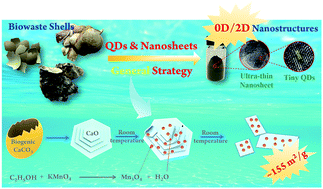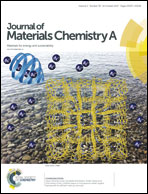Recycling biowaste shells to produce 0D/2D Mn–Ca nanostructures for efficient trace-level metal extraction: confined growth of nanosheets and good dispersion of quantum dots†
Abstract
Utilizing biowaste shells (>95 wt% CaCO3) in chemical synthesis can both remediate environmental pollution and produce novel functional materials. Nonetheless, syntheses of nanomaterials from solid matter such as bio-shells are still rare. Herein, we for the first time reported the synthesis of a 0D/2D nanostructure, i.e., Ca(OH)2 nanosheets decorated with Mn3O4 quantum dots, from bio-shells in a green manner. Specifically, eggshells were calcined to form porous CaO that inherited a hierarchical framework from the source shell. The shell-derived CaO was then stirred together with KMnO4 in anhydrous ethanol at room temperature to generate the 0D/2D Ca(OH)2/Mn3O4 nanostructure (denoted as the Mn–Ca composite), in which Mn3O4 quantum dots were evenly dispersed on thin Ca(OH)2 nanosheets. Mechanism studies revealed that a trace amount of H2O released from the redox reaction between KMnO4 and ethanol regulated the slow hydrolysis and exfoliation of Ca(OH)2 nanosheets from the CaO framework. At the same time, the redox reaction generated Mn3O4 quantum dots that were deposited in situ on the Ca(OH)2 nanosheets, i.e., only where H2O was liberated and the hydrolysis of CaO took place. This mechanism allowed the uniform dispersion of Mn3O4 on the newly formed Ca(OH)2 nanosheets. Thanks to its unique 0D/2D structure, this Mn–Ca composite could highly efficiently extract trace-level Pb(II) from synthetic wastewater and outperformed many other Mn-based nanomaterials prepared purely from chemical reagents. This 0D/2D Mn–Ca composite possessed a high capacity for Pb removal (up to 1580 mg g−1 when the initial Pb(II) concentration was 1 g L−1), and it could also scavenge various other heavy metal ions such as Cu(II), Cd(II), Eu(III), Co(II), and Ag(I). Other biowaste shells such as oyster shells and clam shells also successfully produced a functional nanomaterial via the presented methodology. The current findings open a new way for biowaste recycling and may inspire the design of novel nanomaterials.



 Please wait while we load your content...
Please wait while we load your content...